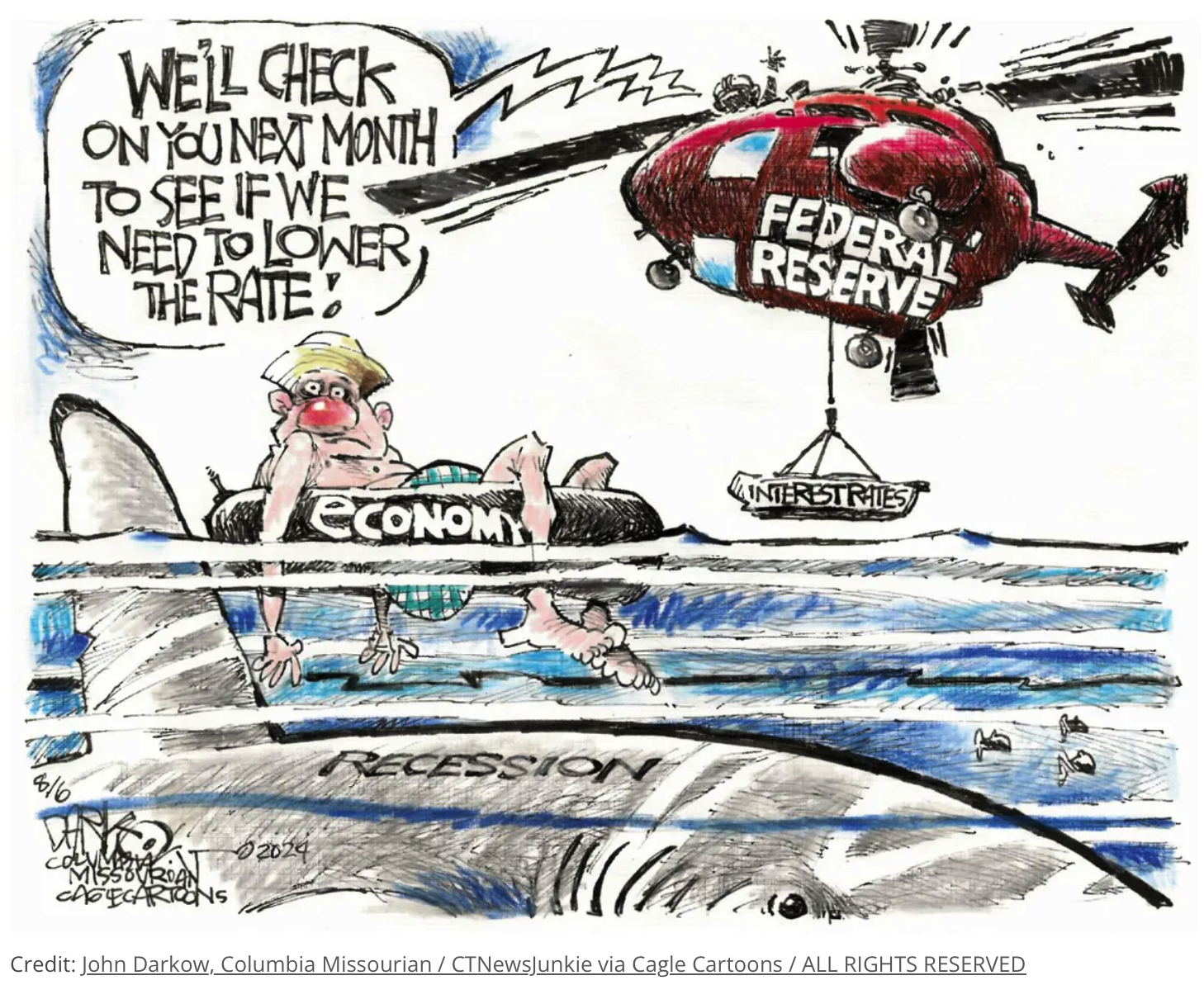The Future is Now: How Technology is Reshaping South Texas Real Estate
Discover how VR, AI, and big data are changing the real estate game. Rachel Tripp REALtor explores the various advanced technologies transforming the real estate landscape, such as virtual and augmented reality, artificial intelligence, predictive analytics, and PropTech platforms.
As a young child in the late 70’s early 80’s, one of my grand-dads was a land developer in Oklahoma City. I can still hear the hum of his assistant’s typewriter and then sound of her voice over the intercom system, a soothing background melody as I remember going to hang out in his office after school and playing under his gigantic desk covered in paper contracts. I would spend what felt like hours trying not to touch the artful paper blueprints of houses and new suburban developments laying around on the floor. I still have the crystal ball paperweight he kept on his desk all those years ago.
Little did I know, those afternoons would lay the foundation for my fascination with the intersection of technology and real estate.
Today, as the industry continues to evolve it blows my mind how quickly things have changed and I know that my granddad would be absolutely giddy if her were around today to be a part of it! From AI-powered property valuations to virtual reality showings, the future of real estate is being shaped by technologies that are (to put it mildly) changing the game. In this article, I’m delving into the cutting-edge solutions that are transforming my industry and what they mean for the future of the real estate transaction.
Believe it or not, but the days of faxing offers and driving across town just to show a listing wasn’t that long ago. The real estate landscape has been steadily evolving thanks to technology (and yes Zillow, I’ll give you street credit for leading the prop tech revolution just so long as you keep working on making your Zestimate more accurate…but you still have a ways to go).
We’ve traded fax machines for e-signatures and bulky MLS books for sleek mobile apps. This shift to digital has been monumental, transforming how we connect with clients, analyze the market, and close deals. The pace of change is at warp speed, and the future of our industry is being shaped by some truly revolutionary tools. Buckle up, because we're about to explore how technology is not just changing the game, but rewriting the rulebook entirely.
A Look Back: From MLS Books to Online Listings
1980’s MLS
For those of us who've been around a while, the journey to today's tech-savvy real estate landscape feels especially remarkable. Back in the day, real estate agents relied on printed MLS books, painstakingly updated and delivered to them weekly. Clients relied on agents to navigate that information labyrinth, often with limited visuals and outdated details. Then came the internet, and with it, the dawn of online listings.
The emergence of local MLS websites marked a significant milestone in real estate. In 1996, the Northwest Multiple Listing Service (NWMLS) pioneered one of the earliest consumer-accessible MLS listing websites, NWRealEstate.com. This platform revolutionized property searches by allowing users to interact with a Quest-like map interface. Upon clicking a specific area, users were presented with a comprehensive list of available properties. Each listing displayed public-facing information, including essential details about the property and a single photograph of the home. This innovation represented a major leap forward in making real estate information more accessible to the general public, completely transforming how people went about searching for homes.
Suddenly, we all had instant access to a treasure trove of property information. Folks could browse listings from the comfort of their homes, complete with photos (sometimes even more than one!). This accessibility was a game-changer, empowering both agents and clients with knowledge and efficiency. But it was merely the beginning.
The Tech Revolution: Transforming Today's Real Estate
Today, we're witnessing a new wave of innovation that's pushing the boundaries of what we thought was possible in real estate. These technologies are not just streamlining our processes; they're fundamentally changing how we interact with properties, clients, and the market itself.
Virtual and Augmented Reality: Stepping Beyond the Screen
Picture this scenario: You're a real estate professional assisting a time-constrained executive from Houston who's eyeing a luxurious beachfront condo in South Padre Island. Traditionally, arranging a property viewing would have been a complex challenge, considering the geographical distance and time constraints. Logistics are a thing.
Moreover, real estate agents are typically restricted to selling properties within and around their own counties of residence and work. This limitation exists because real estate markets are highly localized, and governing boards prefer agents to operate in areas they know intimately. Agents are expected to be transparent about their market knowledge and usually specialize in their local territories.
However, the landscape is changing, y’all! Thanks to technological advancements, particularly virtual reality (VR), agents can now offer clients an immersive property experience without leaving their homes. This innovation bridges the gap between distant locations, allowing for convenient and detailed property explorations regardless of physical boundaries.
VR tours allow clients to "walk through" properties remotely, experiencing the space, the views, and even the ambiance as if they were physically present. They can explore every corner, zoom in on details, and get a true feel for the property's layout and flow. This technology is particularly powerful for showcasing unique properties, highlighting investment opportunities, and connecting with remote buyers.
Augmented reality (AR) takes this immersive experience a step further by overlaying digital information onto the real world through your eyeglasses, smartphones or tablets. Imagine standing in a vacant property with your agent and using AR to visualize different furniture layouts, paint colors, or even potential renovations!! Clients can see their vision come to life, making the decision-making process more tangible, interactive, and exciting.
Real estate lags in adopting metaverse, VR, and AR technologies. While younger generations embrace these tools, only 14% of agents see current impact, and 56% anticipate future influence.
The National Association of Realtors (NAR) recently completed its technology survey and discovered that 67% of agents are spending their own money on virtual reality and artificial intelligence (AI) tools for their businesses. You can count me as one of them. Forward-thinking agents like myself are leveraging these technologies to boost their businesses and stay competitive. I imagine a day in my pipe dream future when eventually brokers will start supporting their agents better in this arena.
Technology in Real Estate Inspections
Looking ahead, the future of real estate inspections is likely to be dominated by more and more advanced technologies. Artificial intelligence (AI) and machine learning will play larger roles, automating parts of the inspection process and providing predictive insights about property conditions. Virtual and augmented reality technologies will become standard tools, allowing for more immersive property previews and inspections that can be conducted remotely.
The inevitable integration of blockchain technology will also revolutionize property inspections by creating immutable records of inspections, repairs, and maintenance. As an agent, this is perhaps the thing I’m looking forward to the most! Imagine a scenario in the near future where the facts are just the facts ma’am, and seller’s disclosures are fail safe…as will be my liability. Huzzah!
*Blockchain technology: This is a decentralized, distributed ledger technology that records transactions across many computers in a way that is secure, transparent, and resistant to modification.Such advancements would not only increase efficiency but also add layers of verification and security to real estate transactions, further enhancing buyer and seller confidence.
Artificial Intelligence: The Rise of the Real Estate Assistant
Let me count the ways in which I am currently in love with Artificial intelligence (AI). AS an already indispensable tool in the industry, AI-powered platforms are emerging as intelligent assistants, capable of analyzing vast amounts of data, identifying patterns, and making predictions with remarkable accuracy. I have two, I named them Greg and Sarah, and yes they do speak for me but not without my input and insight. The rise of Agentic AI has been so incredibly useful and translates into a range of benefits for both agents and clients:
Personalized Property Recommendations: Forget endless scrolling through listings. AI algorithms can analyze a client's preferences, budget, and lifestyle to curate personalized property recommendations. Imagine presenting a curated selection of properties that perfectly match their vision, saving time and effort for everyone involved.
Automated Market Insights and Valuation: Staying ahead of market trends is crucial in my business. AI-powered tools can crunch vast datasets on recent sales, economic indicators, and even neighborhood demographics to provide real-time market insights and accurate property valuations. This has already empowered me to advise clients with greater confidence and make data-driven decisions.
Streamlined Communication and Lead Generation: Responding to inquiries promptly is essential, but sifting through leads can be time-consuming, let me tell you! AI-powered chatbots can be trained to handle initial client interactions, qualify leads, and even schedule appointments, freeing up our time to focus on building relationships and closing deals.
Big Daddy Data and Predictive Analytics: Unveiling the Future of the Market
Remember that crystal ball paperweight I mentioned early on my grandad’s desk? Imagine if he had a crystal ball to predict market fluctuations! By embracing data and predictive analytics, we can get fairly close. While we can't predict the future with absolute certainty, I cannot tell you how much of a game changer this has been for me in my own business.
Sometimes I think we take for granted the power of the supercomputers we all carry around in our pockets these days. Normal non-academic types like myself can now analyze massive datasets, uncovering hidden patterns and trends that would be impossible for humans to spot. Here's how this data-driven approach is shaping the future of real estate:
-Identifying Emerging Investment Opportunities: By analyzing historical market data, economic indicators, demographic shifts, and even social media sentiment, predictive analytics can pinpoint up-and-coming neighborhoods and investment opportunities before they become mainstream.
For Example! Imagine identifying an area ripe for revitalization based on rising property values, increasing young professional populations, and positive social media buzz around new local businesses.
This allows investors to get ahead of the curve, maximizing their return on investment by getting in early!
-Mitigating Risks and Making Informed Decisions: Gone are the days of relying solely on gut feeling and anecdotal evidence. Predictive analytics equips investors with data-backed insights to make informed decisions and mitigate potential risks.
For Example! Analyzing historical data on natural disasters, crime rates, and infrastructure development can help investors avoid properties prone to devaluation.
This data-driven approach minimizes emotional decision-making (not that I would ever let you do that:) and empowers investors with a clearer understanding of potential pitfalls.
-Personalizing the Real Estate Experience: This allows for hyper-personalization in real estate. By analyzing individual preferences, financial situations, and desired lifestyle factors, algorithms can curate tailored property recommendations.
For Example! Imagine a platform that suggests properties not just based on budget and location, but also proximity to preferred activities, school districts, and even noise pollution levels.
A personalized approach streamlines the home buying process, making it more efficient and satisfying for both buyers and sellers.
-Optimizing Pricing Strategies: Predictive analytics empowers sellers and agents to set optimal pricing strategies by analyzing comparable properties, market trends, and seasonal fluctuations
For Example! Algorithms can identify the ideal listing price to attract buyers quickly while maximizing profit, taking the guesswork out of pricing.
-Shaping Future Developments: By analyzing demographic trends, housing demands, and lifestyle preferences, building developers can leverage big data to build projects that cater to future market needs.
For Example! Imagine a developer using data to determine the ideal mix of apartment sizes, amenities, and community features to attract young professionals in a specific neighborhood.
The future is data-driven, y’all and the real estate landscape is evolving rapidly! Those who embrace the power of big daddy data and predictive analytics will be best positioned for success in my personal opinion. By harnessing the insights hidden within data, we can move beyond speculation and make informed decisions that shape a more profitable and efficient future for the real estate market.
PropTech Platforms: The Future of the Real Estate Transaction
The traditional real estate transaction, often fraught with paperwork, legwork, tears, and middlemen, is ripe for disruption my friends. Enter PropTech platforms, the digital disruptors streamlining the entire process, from browsing listings to signing closing documents, all from the convenience of a portal. We’re all pretty used to one of those in pretty much every area of our daily lives these days.
From fragmented services to unified platforms, PropTech is thankfully here to stay and getting more and more powerful. Zillow is the giant most people are familiar with, but they are just one of many coming in hot down the pipeline with more and more powerful collaborations and partnerships.
Gone (not soon enough) will be the days of juggling multiple websites and applications for different stages of a property transaction. Sometimes, a real estate transaction can be an unending game of telephone. Today's leading PropTech platforms are trailblazing and consolidating functionalities to offer a seamless experience. And no, I’m not afraid that they will take my job away, because human’s like myself will always be the appointed fail safe in mediation, advocacy, and translation for their clients (your welcome:).
Imagine more:
Searching and Discovery: You’ll continue those late night searches for your dream home, but they will be immersive and fun via augmented reality.
Financial Planning: You’ll have better access to integrated mortgage calculators, pre-approval services, and financial planning tools to make more informed decisions.
Offer Management: Offers will be submitted and negotiated digitally, tracking their progress, and receiving real-time updates, eliminating the anxiety of traditional methods.
Due Diligence and Closing: You will continue to securely access and review documents, communicate with escrow agents, and e-sign contracts, all within one platform.
5G: What is it anyway?
When I was doing the research for this article looking for current developing technologies that will reshape how real estate is done, for some reason 5G came up a couple of times. Chatbot seems to like to say:
“5G and Enhanced Connectivity: Faster, more reliable internet connections could enable more advanced smart home features and improve remote property management capabilities.”
Look here’s the thing, I’ve said it before and I’ll keep saying it, 5G is a scam. I’d go into that more, but anyone who has spent any amount of time working from their car can attest to my declaration and knows what I’m talking about. I take LTE over 5G anytime, anywhere to write up and send off those offer contracts, and you can tell them I said that.
Me and my grandad Jack, Quail Creek Oklahoma City.
When I reflect on the blueprints of the past in my grand-dad’s office, I am struck by the incredible pace of innovation that has transformed the industry I love. From the clacking of typewriters to the hum of AI-powered algorithms, the future of real estate is being rewritten before our eyes! I am BEYOND excited to see how these cutting-edge solutions will not only revolutionize the industry but also create new opportunities for property owners, developers, and communities alike.
In the words my late grandfather: “Be a moving target”, that the key to success lies in embracing change and staying ahead of the curve. He also said, “If you own land, you’re not poor.” And as we embark on this new era of technological disruption, I am confident that despite how strange, and hard, and impossible all of the relentless change that is coming feels, that the future of real estate will be brighter and more accessible than ever, and I'm excited to be a part of it!
Housing Outlook 2025: How migration is dividing the housing market in two
It's that time of year again when our friends at Altos Research has put together their 2025 Forecast. Today, I'm diving into that report and, while I'm at it, the complexities of the U.S. housing market as we approach the end of 2024 and look ahead to 2025 and then we'll take a look at what is happening in my South Texas market. Do you have reality fatigue? I sure do. I'm here to unpack the latest data and trends for you.
It's that time of year again when our friends at Altos Research has put together their 2025 Forecast. Today, I'm diving into that report and, while I'm at it, the complexities of the U.S. housing market as we approach the end of 2024 and look ahead to 2025 and then we'll take a look at what is happening in my South Texas market. Do you have reality fatigue? I sure do. I'm here to unpack the latest data and trends for you.
The Current State of the Housing Market
As we wrap up 2024, it's clear that the national housing market is anything but uniform. Different regions are experiencing vastly different realities, in politics and in our housing market. Nationally, home prices are set to finish the year with a 5% increase over the previous year. This increase comes despite a historically low number of home sales and a 27% rise in unsold homes on the market compared to last year. This discrepancy highlights the unique and bifurcated nature of the market across the country.
Regional Differences


The U.S. housing market currently exhibits a clear divide:
The Sunbelt: Regions like Austin, Tampa, and Phoenix have seen a significant increase in the number of homes for sale, reaching levels not seen in many years.
The Rustbelt: In contrast, areas like Chicago and Boston have barely seen any increase in unsold homes, remaining tight even compared to pandemic levels.
This division is primarily driven by migration patterns within the country, not immigration. Historically, there has been a significant movement of Americans from cities like Chicago and New York to sunnier locales in the Sun Belt, such as Arizona, Texas, and Florida. However, this migration has stalled in the last two years, particularly in 2024.
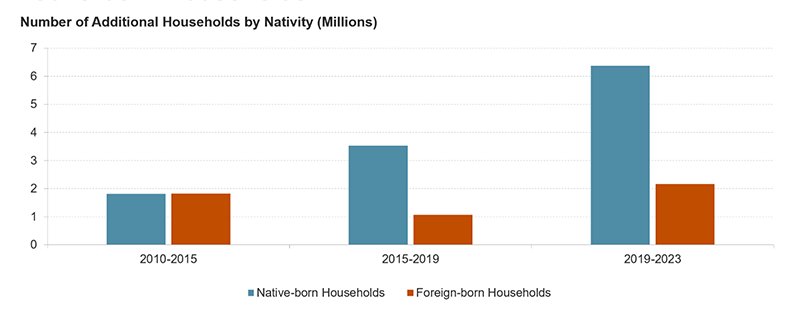
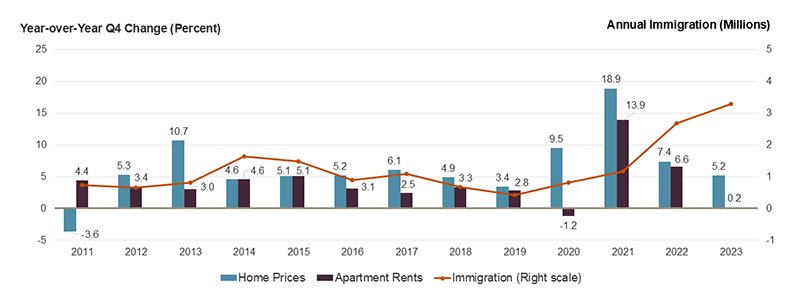
Understanding Migration Trends and Their Impact
The sudden halt in migration has sent shockwaves through the housing market, revealing a complex web of consequences that we have never seen before. In the South, where the once-thundering engines of relocation have sputtered to a halt, a glut of homes now lingers, threatening to upend the delicate balance of supply and demand.
Meanwhile, in the Northeast, the scarcity of inventory continues to fuel a fierce competition among buyers, leaving many to wonder if the dream of homeownership remains within reach and if they should even bother trying anymore until things loosen up. As we navigate this new landscape, one thing is clear: the migration trends of today will shape the housing market of tomorrow.
Economic Factors Influencing Migration
Several economic factors have contributed to this migration freeze:
High Costs: The cost of moving, coupled with expensive housing and mortgage rates, has deterred so many from relocating.
Job Scarcity: Despite low unemployment rates, the scarcity of jobs in desired locations adds another layer of complexity. (We all are tired of hearing that unemployment number…I know. Y’all need to be paying close attention to this. In my own circles I have many friends who have been laid off this past year and struggling to find work, including myself.)
Insurance and Climate Concerns: Rising insurance costs and the risk of climate-related disasters have also made moving to certain Southern markets less appealing. Water is a thing, y’all.
*As we move into 2025, the folks at Altos Research anticipate a slight loosening of this migration freeze, which could help increase inventory in the North and tighten it slightly in the South. But, I have my doubts about that.
Inventory Trends and Predictions for 2025
As of the last week of November 2024, there were 77,000 single-family homes on the market, marking a 27% increase in unsold homes compared to the previous year. This aligns with our expectations for where inventory levels would end the year. Interestingly, we are now only 18% below the pre-pandemic levels of November 2019, suggesting a gradual return to “normalcy” if not out right over supply in some markets.
Future Inventory Projections
Looking ahead to 2025, the inventory of unsold homes is expected to continue rising, though not as dramatically as in 2024. The pace of this increase will largely depend on broader macroeconomic factors and how the suits in the mortgage markets behave. If conditions align, we could see inventory levels approaching those seen before the pandemic by the end of next year.
Seasonal Variations and Market Adjustments
As the holiday season is upon us, the natural ebb and flow of the housing market is already taking effect. With the Thanksgiving holiday falling late this year, inventory levels are expected to dip below 700,000. This seasonal trend is likely to have a more pronounced impact on December's inventory levels compared to previous years. While some may dismiss the seasonal fluctuations, I find it frustrating that many people overlook the data and attribute the slowdown to the seasonal changes, without considering the underlying market dynamics.
Regional Market Dynamics: North vs. South
The bifurcation of the market into Northern and Southern segments presents distinct challenges and opportunities:
Dallas: The increase in available homes is notable, with more homes for sale now than at any time in the last decade.
Chicago: Conversely, there are 60% fewer homes for sale now compared to past averages, illustrating the tight market conditions.
This gap is mainly due to the slowdown in migration from cities like Chicago to Dallas. This trend has been affected by increasing moving costs and a host of economic uncertainties as we enter a new presidential administration.
Anticipated Changes in 2025
While the migration freeze is expected to continue into early 2025, there may be slight movements as conditions evolve. These shifts will be crucial for rebalancing the supply in Northern markets and possibly tightening the Southern markets slightly.
Deep Dive into 78130
As both a resident and an expert in Comal County real estate, I've witnessed firsthand the fascinating market dynamics over the past four years. 78130 is currently experiencing a palpable shift towards a buyer's market, with a predicted moderate decline in home prices over the next 12 months. I’m just going to call it a long needed market correction, even though pretty much everyone I know is in complete denial about that (...it’s just the holidays it’s always this bad…said every sales team lead and armchair housing market expert ever).
Although the potential for growth over a long period is still good, there are a few reasons why the outlook for the near future is not very positive. These include negative recent appreciation, elevated inventory levels, increased seller price cuts, and relatively high mortgage rates. Despite this, there is still strong demographic growth and high wealth levels in the area offer us a more positive counterpoint for the long term.






In a nutshell:
Short-Term Forecast (6-12 Months):
Price Down: Reventure App predicts a moderate decline in home prices, assigning a Home Price Momentum score of 38/100.
Declining Market Indicators: Four out of five key indicators point towards a declining market, including:
Negative Recent Appreciation: Home values declined by 4.4% year-over-year, with the typical home value dropping from $334,527 to $319,791.
Elevated Inventory Levels: The number of homes for sale is 28.7% higher than the seven-year average, signaling potential oversupply.
Increased Price Cuts: 26.3% of sellers reduced their asking price in November 2024, significantly above the historical average of 22.2%.
High Mortgage Rates: The current 30-year fixed mortgage rate of 6.43% sits above the five-year average, potentially dampening buyer demand.
Positive Indicator: Days on Market is currently 18.5% below the long-term average, suggesting continued buyer interest.
Long-Term Growth Forecast (10 Years):
Above Average Growth: Reventure App projects strong long-term growth, with a Long-Term Growth score of 65/100.
Growth Drivers:High Wealth/Income: The median household income is $87,936, and the poverty rate is a low 6.1%, indicating strong economic fundamentals.
Robust Demographic Growth: The area witnessed a 30.2% population increase in the last five years.
Challenges:Below Average Affordability: The Home Value/Income Ratio of 3.64x is near the US average but suggests affordability challenges for some buyers.
Overvaluation: Current home prices are estimated to be 3.3% overvalued compared to long-term norms.






For My Investor’s Outlook:
Average Returns: Reventure App assigns an Investor Forecast score of 53/100, indicating returns similar to the US average over the next decade.
Positive Factors:Strong demographic growth supports long-term appreciation potential.
A 3.3% overvaluation suggests potential for future price appreciation.
Negative Factors:Below average historical appreciation (NaN% over the last 15 years).
Poor rent growth (-0.42% from 2019-2024).
A low cap rate of 4.3% indicates limited cash flow potential for investors, ranking in the 0th Percentile of all housing markets in America in terms of cash low yield.
Note: The "NaN%" figures in the reports indicate missing data, potentially impacting the accuracy of certain long-term projections. Further investigation is required to determine the missing data's significance, y’all.
A note for my investors: The housing market in 78130 has been experiencing a stall out my friends for quite some time now, with short-term price declines anticipated. Although this will create opportunities for my buyers, my investor buyers should proceed cautiously due to limited or down right non existent cash flow prospects. However, the long-term outlook remains positive in my opinion, fueled by strong demographic and economic fundamentals. However, affordability and overvaluation concerns could impact future growth my friends. One way I encourage folks who already live here to raise their voice and combat future appraisal overshoots is to protest your property taxes yearly!!!
Looking Forward: Hope?
I’m not going to sugar coat it my friends, as we approach 2025 the U.S. housing market remains a multifaceted and polarized environment. There's no denying the gravity and the complexity of the situation. The pronounced disparity between Southern and Northern markets, largely influenced by evolving migration trends, does not bode well for next year. Most professionals won’t tell you this, but I will.
The current migration freeze, influenced by high costs, job scarcity, and climate concerns, has created an oversupply in previously popular Southern destinations while maintaining tight conditions in Northern markets. However, I can’t be totally cynical as we enter 2025. There is potential for a slight thawing of this freeze, which could begin to rebalance these regional disparities. I mean, quite literally anything could happen.
The inventory trends projected for 2025 suggest a gradual return to pre-pandemic levels, albeit with continued regional variations to be expected because the housing market is so hyper local. I’m putting out the positive vibe for potential normalization that could bring relief to some markets. However the sad truth about the housing market is that it’s not possible for every market across the us to be simultaneously winning, and there will be significant challenges to offset the wins of others.
Ultimately, the housing market's future will be shaped by a combination of economic factors, migration trends, and regional dynamics. As we move forward, it will be crucial for buyers, sellers, and investors to stay informed about these nuanced market conditions and adapt their strategies accordingly. What’s my motto kids? Adapt and survive.
The bifurcated nature of the current market serves as a reminder that in real estate, location matters more than ever. As we navigate through 2025 and beyond, understanding and responding to these regional differences will be key to making informed decisions in an increasingly complex housing landscape. If you or anyone else you know need help, advise, or a shoulder to take the weight of your uncertainty…I got your back.
Don’t like reading? Greg and Sarah have your back! Here’s the Deep Dive.
Media Changes Tune On Housing Market (Crash Is Here)(?)(!)
Are you feeling the pressure to buy a house right now? The media is sending mixed messages about the housing market, making it difficult to know what to do. Don't be fooled by their fear-mongering tactics. This article analyzes current market trends, including home prices, mortgage rates, and inventory levels, to help you make informed decisions about your real estate journey. Discover the truth about the housing market and gain valuable insights to navigate its complexities.
Are you as confused and annoyed by the mixed signals we are getting lately about where mortgage rates are going? You’ve heard the media telling us...if you don't buy a house now you will be MISSING OUT!!!
Hmmm...that FOMO peddling sounds vaguely familiar, right? Not too long ago we were "living our best Covid lives" dancing along with pretty TikTok-ers making sourdough bread.
I am to no end annoyed by their predatory messaging: Hey kids if you don't buy a house now, you WILL be missing out on the greatest opportunity for wealth in your entire lifetime.
Hold up. The truth is, you cannot trust mainstream media when they tell you that when the Fed continues to do rate cuts, mortgage rates will get down to 4% or even 3%. A few months ago mainstream media were telling folks ‘don't worry mortgage rates will go down as the Feds keep cutting’, as if what the Fed does with interest rates have any influence on how mortgage rates behave. Now they are telling you the opposite...y'all better buy a house now, because if you don't you will be in an even worse position because mortgage rates will continue to go up. Mainstream media have completely reversed their tune y'all.
CNN just a week ago put out an article saying that if you didn't buy a home in the last six months when the Fed cut rates...too bad, so sad, you made a mistake. And to add more water to an already boiling over pot, I still hear licensed professionals encouraging folks to date the rate. This, in my opinion, is absolutely the worst advice to hit us since they said skinny jeans make everyone look good. I don’t mean to trivialize what is happening to my neighbors in our housing market by comparing it to the skinny jean trend..but can we all agree that we are happy it’s finally going away?
They are finally right about one thing though: the Fed will likely continue cutting rates through the end of 2024, but this won't make housing any more affordable my friends. In fact, owning a home has never been more costly than it is today. It's hard to watch the news without feeling disheartened by the headlines about massive price drops in Texas, widespread issues in Florida, and a struggling housing market in New York. Property taxes are soaring, HOAs are out of control, and interest rates are expected to remain above 6% for at least the next two years. (Of course, this rate prediction comes from the National Association of Realtors, one of the largest lobbying groups in the U.S., so take it with a grain of salt. *discalaimer, I am a member of NAR).
They claim that if you had purchased a home six months ago, you would be ahead now, but the truth is that anyone who bought recently in those markets is likely seeing their property values plummet. With skyrocketing assessments, record-high home insurance rates, and no assurance that insurance companies will support their clients during crises, the situation looks bleak.
If you feel the pressure is on to buy a house as soon as possible because it's only going to get more expensive, well you're not totally wrong about that. However, you must have your head in the deal game and rely more on what the data is telling you. Rely less on what folks like Barbra Corcoran say when they get up one morning and decide to preach to you in the soft light of the CNN or FOX studios. This isn't an episode of the Shark Tank..this is your financial health, so take the data seriously. Let's dive in and talk numbers shall we?
Analyzing the Current Market
Seasonal Trends in Home Prices and Mortgage Rates
As we delve into the current state of the housing market, it's evident that there are seasonal fluctuations influencing both home prices and mortgage rates. Typically, home prices peak during the late summer months, as observed in June 2023, and similarly in previous years. This pattern aligns with the data from June 2022 and the peak around June and July in 2023.
Historical Context and Mortgage Rate Fluctuations




In January 2021, mortgage rates reached an unprecedented low of approximately 2.7%. This significant decrease sparked a notable rise in home prices later that year, especially in August, when the average rate for refinancing stood at around 2.75%. These exceptionally low rates played a crucial role in driving up home prices as the year progressed.
Year-Over-Year Home Price Changes:
2021 : Home prices saw a significant increase, up by 18% year-over-year, which was an unsustainable surge in the market.
2022: The increase was more moderate at 8%, reflecting a slight cooling from the previous year.
2023: Currently, home prices are up by approximately 4% from the same time last year, indicating a return to more normal growth rates in the range of 3-5%.
Mortgage Payments and Interest Rates
*Rates go up from July to August 2024
In August 2024, the average monthly mortgage payment rose to $2,667, calculated at an interest rate of 6.78% according to Freddie Mac's latest data as of August 1st. This rate is based on a weekly survey and may differ from daily rates, which were lower at the end of the first week. Despite this, the current mortgage payment is only $168 below the all-time high set a few months ago, reflecting the ongoing pressure on affordability. If it seems like there are forces invisible to the naked eye contributing to what influences mortgage rates, you have good intuition.
The mortgage industry has long advised homebuyers to follow the "30% rule," which suggests that housing expenses, including mortgage payments, should not exceed 30% of one's income. This guideline has traditionally been used to determine an acceptable debt-to-income ratio for homebuyers. However, the NerdWallet quarterly First-Time Homebuyer Affordability Report indicates that adhering to this principle has become increasingly difficult in the current real estate market, primarily due to rapidly rising home prices.
Dynamics of Current Home Sales and Listings
Pending Home Sales
Pending home sales, a leading indicator of housing market activity, fell by nearly 6% in the four weeks ending July 28th. This is the largest decrease in nearly nine months, which could be a precursor to changes in the market, especially considering the recent drop in interest rates.
New and Active Listings
While new listings increased by 4%, this was the smallest increase in nearly nine months. Active listings, which represent the total housing inventory, rose by nearly 19%, yet this too was the smallest increase in about three months.
These trends suggest that while there is a decrease in demand, the inventory is not increasing at a rate that would suggest a market crash.
Analyzing the Supply and Demand



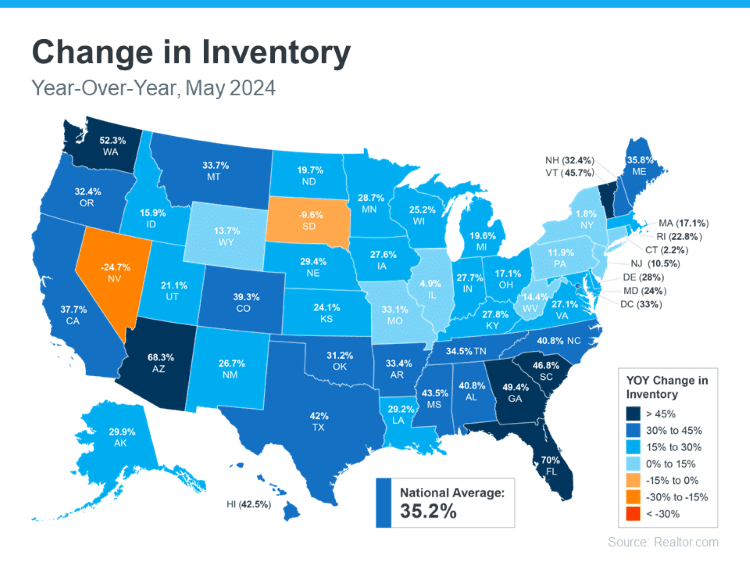
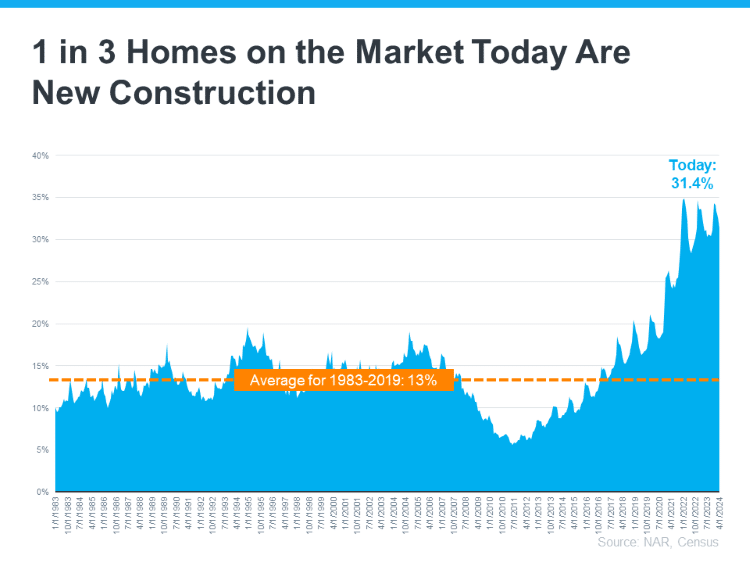
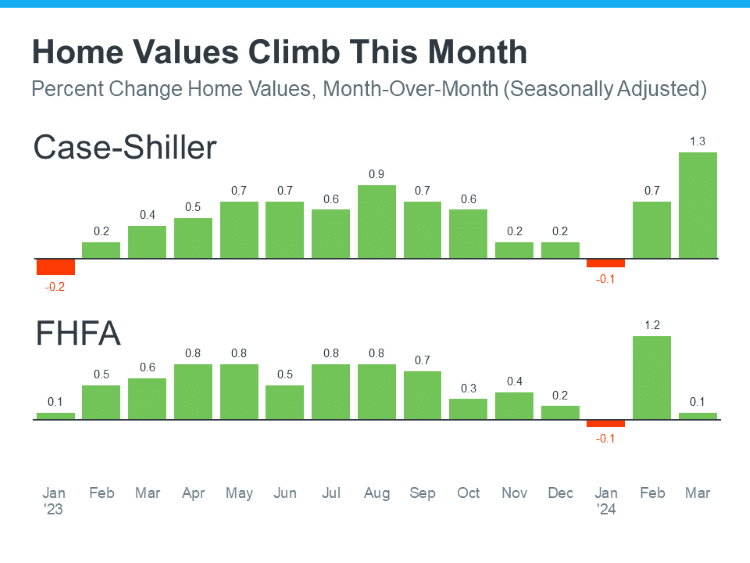
The supply side shows a modest (not substantial..calm down NAR) 4% year-over-year increase in new listings, significantly lower than the double-digit increases seen earlier in the year. On the demand side, there's a notable decrease in pending home sales , with a 5.7% drop from the previous year, indicating a significant reduction in buyer activity. This decrease in pending sales is a critical factor to watch, as it could signal a potential shift in the market dynamics.
Active Listings and Inventory Trends
Active listings have shown an unusual pattern, peaking in June rather than the late summer months, which is atypical for the housing market. This early peak suggests a shift in the usual seasonal trends and could impact future home prices and market stability. Despite this peak, we are still experiencing a three-year high in active listings for the same timeframe, indicating a more robust inventory than in recent years.
Month Supply of Homes
The current month supply of homes stands at 3.8 months, which is an increase of 0.8 percentage points from last year. This figure represents how long it would take to sell all current listings at the current sales pace if no new listings were added. A balanced market typically has a 4-5 month supply, so while we are closer to this range, the market still slightly favors sellers.
Variations in Regions and Metro Analysis
Different regions and metros are experiencing varying trends:
Detroit, Michigan: Leads with a significant increase in median sale prices, up by 17.2% year-over-year.
New Brunswick, New Jersey: Follows with a 15% increase.
Providence, Rhode Island and Milwaukee, Wisconsin: Both have seen substantial price increases of over 13%.
Conversely, Austin and Dallas have seen slight decreases in home prices, indicating regional disparities in market conditions.
Market Predictions and Future Trends
Looking ahead, the housing market's future will largely depend on the interplay between supply and demand. If pending home sales continue to decrease and new listings do not rise significantly, we could see a shift towards a more balanced or even a buyer's market. However, the current data suggests a gradual adjustment rather than a sudden market downturn.
Food for thought: Two things can be true at once: It will be a buyer's market for awhile, and buyers are priced out.
Impact of External Factors
External factors such as economic policies, interest rates, and global events also play a crucial role in shaping the housing market. For instance, any changes in federal interest rates can directly impact mortgage rates, influencing both buyer affordability and market dynamics.
The housing market is exhibiting signs of a gradual shift towards normalization after the unprecedented fluctuations of the past few years. While the market still slightly favors sellers, the increasing month supply and regional variations indicate that we may be moving towards a more balanced market. Homeowners, buyers, and investors should keep a close eye on these trends as they plan their next steps in the housing market.
The month supply of homes, a critical indicator of market balance, has seen a noticeable increase this year. As of now, the month supply stands at 3.8 months, up from 3 months at the same time last year. This increase is part of a seasonal trend observed in June and July each year, with the exception of 2021 when the market experienced near-record low rates.
Historical Perspective on Month Supply
July 2019: Month supply was at 4.2 months.
July 2018: Month supply stood at 4.3 months.
July 2017: The figure was again at 4.2 months.
July 2016: Month supply was higher at 4.7 months.
The average for July from 2016 through 2019 was approximately 4.4 months, indicating that while the current supply is a three-year high, it is still below the historical norms of pre-COVID levels.
Regional Analysis of Home Prices and Sales


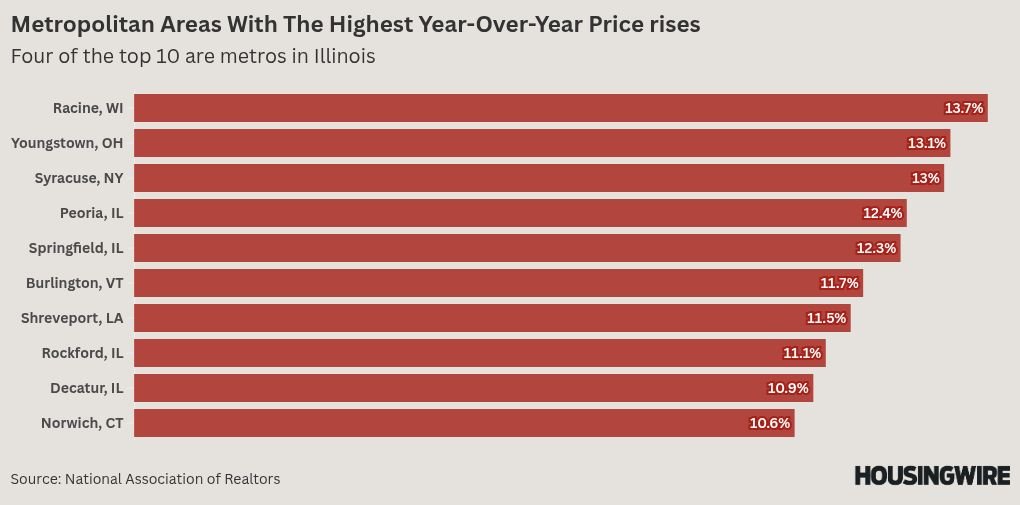
The dynamics of home prices and sales vary significantly across different regions and metros. Here’s a closer look at some specific areas:
The Top Performers in Home Price Increases:
Detroit, Michigan: Led the nation with a 17.2% increase in median sale prices year-over-year.
New Brunswick, New Jersey: Saw a 15% increase.
Providence, Rhode Island and Milwaukee, Wisconsin: Both experienced significant increases, with Providence at 13.6% and Milwaukee at 13.3%.
The Metros with Declining Home Prices:
Austin, Texas: Experienced a decrease of 2.3%.
Dallas, Texas: Saw a slight decrease of 4%.
Pending Home Sales Insights
Gains: Only seven metros posted gains in pending home sales from the previous year, including San Francisco, California, and Miami, Florida, which saw increases of 3.2% and 2.8%, respectively.
Losses: The majority of metros experienced declines, with significant drops in cities like Phoenix, Arizona, and Las Vegas, Nevada, where pending sales fell by 5.7% and 6.1%.
Understanding the Shifts in Market Dynamics
Real estate markets dance to their own tuned and are hyper local, with home prices and sales fluctuating from region to region. While some areas enjoy robust growth, others grapple with declines, reflecting the diverse economic and demographic forces at play. These localized trends are crucial for both homebuyers and investors to understand before making any decisions.
The Influence of Economic Policies on Regional Markets
Economic policies, including tax incentives and zoning regulations, significantly impact regional real estate markets. For instance, areas with favorable tax conditions and growth-friendly policies tend to attract more residents and investors, which boosts home prices and sales activity. Conversely, regions with restrictive policies may see a stagnation or decline in market dynamics.
Future Outlook and Strategic Considerations
As we move forward, the real estate market will continue to adapt to the ongoing economic and demographic shifts. To make informed decisions, it's crucial to stay updated on national trends and local market conditions. If you have any questions about the Texas real estate market in particular, call me! There isn’t a whole lot I love more these days than talking real estate.
Strategic Buying and Selling Tips
For Buyers: Focus on areas with strong economic growth and stable job markets. Consider the long-term potential of the area and factor in the total cost of homeownership, including taxes and insurance.
For Sellers: Emphasize the unique features of your property and community. Be realistic about pricing, especially in markets experiencing a slowdown. Timing is everything, there are ways to make sure that your sale coincides with peak buyer activity in your region.
Navigating Market Uncertainties
The real estate market is inherently unpredictable y’all. Understand the underlying factors. By being adaptable, you will be able to navigate these challenges with efficiency. The key is: BE ADAPTABLE. Whether you're a first-time homebuyer or on your tenth investment property. Staying informed is a discipline. Adjusting your strategies accordingly is the key to not loosing your shirt.
FOCUS ON PURCHASE PRICE, NOT RATES!
The real estate market is a complex and dynamic lover my friends, influenced by a world of seemingly invisible factors such as economic policies, demographic shifts, and regional disparities. It’s VERY easy to be seduced by her. The good news is, you can have a healthy relationship with your housing market. By analyzing these elements and staying informed, you can make more strategic decisions and navigate the market with greater confidence and less risk.
As we move forward, it will be interesting to see how these trends evolve and shape the future of real estate.
Remember, whether you're buying, selling, or monitoring the market, knowledge is your most valuable asset! There are no stupid questions. Drive slow, the jerk on your back bumper will go around and be no further than you are by driving like an animal. Stay informed, stay flexible, and stay proactive in your real estate endeavors.
What are your observations and experiences in your local market? I'd love to hear about them! Feel free to share your insights, whether you're noticing similar trends or experiencing something different, as they can help me to better understand the broader market dynamics.
Fields of Dreams or Nightmares: San Antonio's Stadium Proposal and Housing Crisis
The ongoing controversy surrounding a proposed baseball stadium project in San Antonio provides a compelling case study of this complex balancing act, let’s take a look at this big stadium project idea that’s shaking up The Lone Star City.
*The plan aims to create a $160 million stadium for the San Diego Padres' AA affiliate along San Pedro Creek in downtown San Antonio. The stadium is slated to be finished for opening day in April 2028.
As a Texas Realtor, my love for the Lone Star State runs deep, rooted in childhood memories of summer visits to see my dad and my stepmom. Every year, my mother would put me on a Southwest Airlines flight from Oklahoma City, and I'd eagerly anticipate those honey roasted peanuts and the cherished pilot's wings!! I can still recall the thrill of being invited into the cockpit – the special treat they would give to us divorced kids flying solo back in the day that's sadly no longer possible. These formative experiences sparked my passion for Texas, ultimately leading me to call San Antonio home. I’ve been to the Alamo more than most normal people. Spoiler alert, there is no basement.
Today, I witness San Antonio as a city on the rise y’all, with our vibrant culture, a growing economy, and a rich history that continues to captivate both residents and visitors alike. However, beneath the surface of this bustling metropolis lies a stark reality: an affordable housing crisis is gripping the Alamo City, leaving many residents struggling to keep a roof over their heads. As a realtor deeply connected to this community, I'm committed to addressing this challenge and helping my fellow Texans navigate such a complex housing market.
The city’s current situation brings to light a critical question faced by growing urban centers across the nation: how can cities prioritize economic development while also ensuring the well-being and stability of their residents, especially those most vulnerable to displacement?
The ongoing controversy surrounding a proposed baseball stadium project in San Antonio provides a compelling case study of this complex balancing act, let’s take a look at this big stadium project idea that’s shaking up The Lone Star City.
A City in Crisis: The State of Affordable Housing in San Antonio
San Antonio is currently grappling with a severe shortage of affordable housing options. The crisis affects both renters and homeowners, as evidenced by the statistic that half of all renters and a quarter of homeowners in San Antonio are considered “housing cost-burdened,” meaning that they spend at least 30% of their income on housing. The monetary strain can trigger a domino effect on people and households, compromising their capacity to cover essential expenses, set aside funds for upcoming needs, and play an active role in stimulating the local economic landscape.
Rising costs are a primary driver of the crisis we face. Coupled with the scarcity of deeply affordable housing options, this trend is pushing many residents to the brink of financial instability. Families are often forced to relocate to more affordable areas, even if it means leaving their communities and support networks behind.
A Home Run for the City? The Proposed Baseball Stadium Project
At the heart of this controversy lies a proposed $160 million baseball stadium and entertainment district project. Designated Bidders LLC, the entity that owns the San Antonio Missions baseball team, is spearheading the project, with the aim of constructing the stadium near the San Pedro Creek Culture Park.
The City Council and Bexar County Commissioners Court have already approved the project's financing plan, which includes $126 million in city bonds, $34 million from the Missions owners, and anticipated revenue from a Tax Increment Reinvestment Zone (TIRZ). The projected economic benefits, including revitalization of a previously neglected area, job creation, and the establishment of a new community asset, have fueled support for the project.
However, the project faces a significant hurdle: land acquisition. The proposed stadium requires a 2.3-acre parcel currently owned by the San Antonio Independent School District (SAISD) and used as a parking lot for Fox Tech High School.
A Strike Against Affordable Housing? The Soap Factory Apartments Controversy
A major point of contention surrounding the proposed development is the planned demolition of the Soap Factory Apartments, a 381-unit complex offering relatively affordable housing in downtown San Antonio. This decision has sparked outrage among residents, housing advocates, and community leaders.
Sarah Honeycut, a tenant of the Soap Factory Apartments, was quoted saying, "It's disheartening to know you are so easily sacrificed on the altar of the almighty dollar." The planned demolition highlights a key concern shared by many: that the pursuit of economic development is coming at the expense of those who can least afford it.
The potential displacement of hundreds of tenants raises serious concerns about exacerbating the existing affordable housing crisis and potentially increasing homelessness in San Antonio. Although relocation assistance is being offered, critics argue that the proposed $2,500 rental relocation packages are insufficient to address the long-term needs of displaced residents, especially given the already limited availability of affordable housing in the city.
SAISD Steps Up to Bat: Leveraging Land Ownership for Community Benefit
In a move that has injected further complexity into the situation, SAISD is leveraging its ownership of the necessary land parcel to push for substantial community benefits. Superintendent Jaime Aquino has outlined stringent terms for the land sale, including the following demands:
Construction of a $45 million building for the Advanced Learning Academy
A guarantee of at least 1,250 affordable housing units within SAISD boundaries
$400,000 in annual compensation for forgoing a competitive bidding process
A seat for Aquino on the TIRZ board overseeing the stadium project
A new parking garage with 250 spaces for Fox Tech High School
SAISD is emphasizing that affordable housing commitments are non-negotiable, arguing that the district has a responsibility to prioritize its educational mission and support its students and families, many of whom are struggling with the affordable housing crisis.
Deputy Superintendent Patti Salzmann stated that “[SAISD officials] believe that having the superintendent serve as a representative on the TIRZ board would protect SAISD’s long-range master plan and interests, and mitigate or avoid further declines in enrollment.” This comment highlights the district's belief that the lack of affordable housing is directly impacting its student population.
A High-Stakes Game: The Path Forward
*Estimated taxable value
The proposed baseball stadium project has ignited a heated debate in San Antonio, pitting economic development against the urgent need for affordable housing. With SAISD's bold demands on the table, the project's future hangs in the balance. Designated Bidders faces a December 9 deadline to present a counteroffer to SAISD, and the SAISD board is scheduled to vote on the proposal on December 16.
The outcome of this negotiation will have far-reaching consequences for the city. If the stadium project moves forward without adequate provisions for affordable housing, it could exacerbate the existing crisis, displacing residents and further straining an already burdened system.
On the other hand, if SAISD’s demands are met, the project could serve as a model for equitable development, demonstrating that economic growth and social responsibility can go hand in hand.
Conclusion: A Call for Comprehensive Solutions
The San Antonio Missions ballpark project presents a complex dilemma, one that reflects a broader national conversation about the challenges of balancing economic development with the need for affordable housing. SAISD's assertive stance highlights the critical role of community stakeholders in shaping development outcomes and holding decision-makers accountable.
Ultimately, the project's fate hinges on the willingness of all parties to find a solution that balances competing interests and prioritizes the needs of San Antonio residents.
The situation is one that should give us pause for thoughtful debate, and emphasizes the need for comprehensive affordable housing policies that go beyond the scope of individual development projects. San Antonio, like many other cities grappling with similar challenges, must prioritize the creation and preservation of affordable housing as a cornerstone of its urban development strategy.
Councilmember Teri Castillo's proposed housing policies, the CLT Tiered Affordability and Stay SA initiatives, offer potential solutions. These policies focus on promoting community land trusts, streamlining affordable housing production, and preserving the existing affordable housing stock.
While the powers that be don't offer details on their implementation or potential drawbacks, these policies, if effectively implemented, could represent a significant step towards addressing San Antonio's affordable housing crisis and ensuring that all residents have access to safe, stable, and affordable housing.
What will the Donald Trump presidency mean for the US housing market in 2025?
Well, folks, it happened! The Trump Train rolled right back into the White House, and now we're all wondering what this means for our real estate market. Buckle up buttercup, because we're about to take a wild ride through what the red, white, and gold-plated world of Trump's second term could mean for real estate!
Well, folks, it happened! The Trump Train rolled right back into the White House, and now we're all wondering what this means for our real estate market. Buckle up buttercup, because we're about to take a wild ride through what the red, white, and gold-plated world of Trump's second term could mean for real estate!
Remember when we thought 2020 was unpredictable? Ha! Welcome to 2025, where the housing market might just be as dramatic as that reality TV season finale you all know you DVR’d!! But don't worry, I’m here to be your personal "Art of the Deal" decoder ring.
So, what's on the landscape for the next four-years? Will we see more apartment buildings and skyscrapers sprouting like weeds? Are we in for the potential of home prices rising? Or will the market be as plateaued as Trump's famous coif?
I’ll get into all the juicy details faster than you can say "You're fired!" at a bad property listing. From potential tax shakeups to infrastructure bonanzas, it’s going to be an interesting first year back in the Oval Office for Trump. My goal is to help translate all the political talking head’s jargon into real talk for your real estate decisions. Ready to make your real estate portfolio great again? Let’s dive into it.
The Influence of Trump's Election on Mortgage Rates
One of the first questions that comes to mind with Trump's election is: How will it affect mortgage rates? Interestingly, there has been a noticeable spike in mortgage rates since mid-September, with rates climbing back to around 7%. This rise has left many puzzled about the underlying causes. A significant factor to consider is the "Trump trade." A tweet from Jim Biano, president of Bianco Research,LLC highlighted a correlation between Trump’s betting odds to win the election and the 10-year US Treasury yield. As Trump's odds increased, so did long-term interest rates, suggesting that the market anticipates higher long-term rates under Trump's presidency.
Despite Trump being a pro-business figure who has historically pressured the Federal Reserve to cut interest rates, his presidency might paradoxically be associated with higher borrowing costs. This could potentially dampen home buyer demand. The Committee for a Responsible Federal Budget estimates that US debt will rise by $7.8 trillion from 2026 to 2035, largely due to Trump's fiscal policies. Moreover, Trump's penchant for tariffs, including a proposed blanket tariff of 10-20% on all imports and even higher tariffs on goods from China, could lead to inflationary pressures, further pushing up interest rates and mortgage rates.
Trump's Potential Impact on Home Buyer Confidence and Market Dynamics
Despite the possibility of higher mortgage rates, Trump's pro-business stance could boost economic confidence and optimism about the housing market. This was evident from past data, such as the mortgage purchase application index, which saw a significant increase following Trump's election in 2016. This suggests that Trump's election could initially inspire confidence among potential home buyers, potentially stabilizing or even increasing home prices.
Slow down though! The current state of the housing market presents new challenges. Affordability metrics are at their worst, with the monthly cost of buying a home now reaching $2,800, a stark increase from $1,200 when Trump first took office. The typical home buyer now spends 40% of their income on mortgage costs, up from 24% in 2016. High mortgage rates and continuing stringent qualification criteria for mortgages might (could and would) continue to lock out many prospective buyers, raising questions about the real impact of presidential policies on the housing market's fundamental issues.
The Looming Threat of Foreclosures and Government Intervention
Looking ahead to 2025, another significant concern is the potential increase in foreclosures. Trump's less hands-on approach compared to the Biden-Harris administration could see a rollback of forbearance and loss mitigation efforts that have so far prevented many foreclosures. Data from the November ICE Mortgage Report, The nation's leading source of mortgage data and performance information, covering most of the market, indicates a worrying trend: early-stage delinquencies for 2024 vintage originations have reached 1.7%, the highest in 16 years. This spike in delinquencies, particularly among VA and FHA loans, could herald a wave of foreclosures, especially if Trump reduces government intervention in the mortgage market.
The Biden-Harris administration has taken steps to help prevent foreclosures, like automatically enrolling borrowers who've fallen behind on their payments into more affordable plans and making it tougher for lenders to take away their homes. While some folks have raised concerns about using taxpayer money to help homeowners who don't have much equity in their properties, the goal is to keep people in their homes and avoid the chaos that comes with a surge in foreclosures. If the Trump administration were to reverse these policies, it could lead to a rise in foreclosures, which could have a ripple effect on the housing market and even drive down home prices.
The Role of Fannie Mae and Freddie Mac in Trump's Housing Policy
Get ready for a potential shake-up in the world of government-backed mortgages, y’all! The Trump administration is considering privatizing Fannie Mae and Freddie Mac, two giants that support around half of all mortgages in the US. If they sell off a chunk of their government stake to private investors, it could significantly reduce the government's role in the housing market - a move that aligns with Trump's more hands-off approach to economics.
So, what does this mean for the housing market? Well, privatization could lead to higher mortgage rates since the government's backing would be reduced. This could make it tougher for buyers to afford homes and impact market stability. On the other hand, it could also lead to more competitive practices in the mortgage lending market, which could be a good thing!
*Fannie Mae financed home purchases for millions of American soldiers returning from World War II. The nation’s economy grew rapidly and the liquidity Fannie Mae provided allowed mortgage lenders to have the cash on hand to meet the demand.
Are you wondering who Fannie Mae and Freddie Mac are? They're two government-sponsored enterprises (GSEs) that play a huge role in the US housing market. Fannie Mae was created in 1938 to provide financing for homeownership, while Freddie Mac was established in 1970 to provide financing for multifamily housing. Today, they're responsible for backing around half of all mortgages in the US, which is a whopping 31 million mortgages!
The short to the long of it is: Fannie Mae and Freddie Mac buy mortgages from lenders, package them into securities, and sell them to investors. This allows lenders to make more loans and helps keep mortgage rates low. The government provides a guarantee to these securities, which makes them more attractive to investors. By privatizing these institutions, the government would be reducing its role in the housing market and allowing private investors to take on more risk.
It's worth noting that privatization is just a proposal at this point, and there are many details that still need to be worked out. But if it does happen, it could have significant implications for the housing market and the millions of Americans who rely on Fannie Mae and Freddie Mac for their mortgages.
Trump, Tariffs, and Tangles: Will the Housing Market Duck or Dive?
As we look ahead to Trump's presidency, it's clear that the broader economic landscape and the Federal Reserve's policies will have a huge impact on the housing market. And let's just say, Trump's relationship with Jerome Powell, the head of the Federal Reserve, has been a bit rocky. Trump has publicly criticized Powell and has been pushing for lower interest rates. The Fed's decisions, especially when it comes to interest rates, will play a huge role in shaping the direction of the housing market.
Trump's economic plans, which include big tax cuts and potentially aggressive tariffs on imports, could give the economy a short-term boost. But they could also lead to higher inflation and increased costs for consumers. And that's where things will get real interesting - these factors could either help or hurt our housing market, depending on how they interact with other economic factors like wage growth and employment rates.
For instance, if wages start to rise and people have more money in their pockets, they might be more likely to buy or invest in homes. On the other hand, if tariffs lead to higher prices for building materials and other goods, that will make it harder for builders to keep costs down and for buyers to afford homes. So, it's a complex picture my friends. Which will come first? The chicken or the egg? Will wages go up? Will building get cheaper? Unfortunately, we'll just have to live through these factors playing out to get a true sense of what the future holds for our housing market under Trump's presidency.
What’s Good in the Hood? The Importance of Being Aware of Local Market Fundamentals
While national policies and economic trends are important, the most critical factors for home buyers and investors are often local market conditions. Understanding the fundamentals of your local housing market, such as cap rates and historical price trends, is critical for making eyes wide open decisions. Cap rates, for example, provide valuable insight into the potential return on investment in different regions and can indicate whether it's a favorable time to buy or invest in a particular area…so don’t ignore them!
When it comes to investing in a single-family rental home in Texas November 2024, the right capitalization rate (cap rate) depends on a few key factors. First and foremost, there's your personal risk tolerance. Are you looking for a steady income stream with minimal risk, or are you willing to take on more risk in pursuit of potential growth? If you're looking for stability, a cap rate of 4-5% might be the way to go. But if you're willing to take on more risk, a cap rate of 8-12% could be more appealing.
Some investors, particularly those with a more aggressive approach, tend to shy away from properties with cap rates below 8%. In fact, some may even require double-digit returns. However, it's essential to consider the diverse range of factors influencing investment decisions. A cap rate of around 6% can be considered exceptionally attractive in the market you are buying in! In Texas, for example, many homeowners have low mortgage rates, which can limit the supply of homes available for purchase. This can impact the cap rate you're looking for.
Finally, the property itself is a major consideration. What's the property's location, condition, and potential for renovation or redevelopment? These factors can all influence the cap rate you're looking for.
By considering these factors, you can get a better sense of what cap rate is right for you and your investment goals.
Will 2025 Be Better?
As we head into the new year, it's clear that the housing market is in ongoing trouble, and we're looking at a complex web of factors that will shape the market's direction. From new government policies (or lack there of) to economic strategies and the actions of the Federal Reserve, there’s a dizzying array of things to keep track of.
But here's the thing: while it's important to stay informed about national trends, it's your local market that will ultimately make or break your real estate decisions. This is not a new rule, it has always been the case. Whether you're a home buyer or investor, understanding what's happening in your own backyard is crucial. Too many get suckered into the shiny sales pitch before we do our homework.
So, what does this mean for your action plan? It means staying informed about both national trends and local conditions keeping an eye on the big picture, but don't lose sight of what's happening in your own community! Pay attention to your city government. Go to those city council meetings! Be a sponge! By doing so, you'll be better equipped to navigate and possibly predict the chaos of the real estate market in 2025 and beyond.
In the end, while geeking out on macroeconomic and political climates is certainly an important activity, it's really understanding local housing market dynamics that will ultimately hold the key to shooting for success in real estate investment and homeownership. Stay informed, stay local, and get ready to make some moves in the 2025!
AGAIN REMEMBER KIDS: ALL REAL ESTATE IS LOCAL, even if the White House looks more like Mar-a-Lago these days. Do you know what else is local? You are! It’s impossible to predict what the housing market under Trump will look like this time around. What you can know is that neighborhood and financial knowledge is POWER.
And don’t forget to get your buyer’s agency with a REALtor in your neck of the woods. If you’re in Texas…I’ll help you navigate your neighborhood market, whether you're in a blue county, a red county, or somewhere in the purple haze in-between!
"There have been few things in my life which have had a more genial effect on my mind than the possession of a piece of land." —Harriet Martineau
"There have been few things in my life which have had a more genial effect on my mind than the possession of a piece of land." —Harriet Martineau
Texas law requires all license holders to provide the Information About Brokerage Services to Prospective clients
⭐️⭐️⭐️⭐️⭐️ TESTIMONIALS ⭐️⭐️⭐️⭐️⭐️





























































